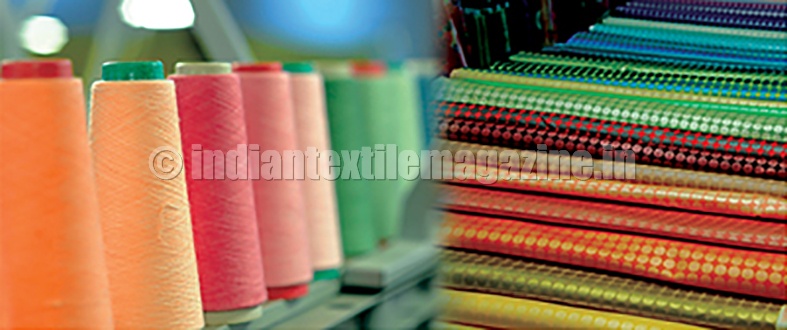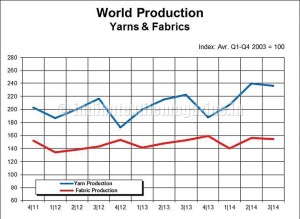Global yarn production decreased in the third quarter of 2014 compared to the previous quarter due to lower output in Asia and Europe. During the same period, yarn production in North America increased moderately, while in South America it recorded a strong rise. On an annual basis, global yarn production rose and was supported by a strong increase in Asia. On the contrary, in Europe, North and South America yarn output fell year-on-year.
Global fabric production fell in the third quarter of 2014 compared to the previous quarter with all regions showing decline. However, on an annual basis world fabric production improved. Thereby, output in Asia and Europe increased, while it fell in South America. World fabric stocks in the third quarter were increased quarter-on-quarter with all regions supporting this development. Year-on-year, the picture was mixed with increases in Asia and North America and decreases in Europe and South America. Overall, global fabric inventories fell annually. Fabric orders in the third quarter fell in Europe and rose in Brazil quarter-on-quarter as well as year-on-year.
Estimates for yarn production for the fourth quarter of 2014 are positive in Asia and Europe, but negative in North and South America. Estimates for fabric production for the fourth quarter are positive in Asia and Europe but negative in South America.
The outlook for yarn production for the first quarter of 2015 is positive in Europe and unchanged in Asia. The same pattern applies to the outlook for fabric production. For the first quarter it is positive in Europe and unchanged in Asia.
In the third quarter of 2014, global yarn production fell by 1.3 per cent quarter-on-quarter. Thereby, output in Asia and Europe decreased by 1.4 per cent and 5.7 per cent respectively. In North and South America yarn output climbed by 1.1 per cent and 5.7 per cent in the Q3/2014 compared to Q2/2014. In comparison to Q3/2013 worldwide yarn production witnessed a rise of 6.3 per cent. This was supported by an increase of 7.3 per cent in output in Asia, whereas the other regions saw declines of 3.1 per cent annually in Europe, 2.4 per cent in North America and 12.3 per cent in South America.
Global fabric production fell by 1.3 per cent in Q3/2014 compared to the previous quarter. The strongest decline of 8.3 per cent was recorded in South America, followed by Europe with 7.6 per cent. In Asia fabric output fell moderately by 0.4 per cent. In contrast, global fabric output increased by 1.3 per cent year-on-year supported by rises in Asia (two per cent) and Europe (2.9 per cent). In South America, however, fabric production fell by 11.4 per cent annually.
Global yarn inventories rose by 0.9 per cent in Q3/2014 quarter-on-quarter. Thereby, Asian inventories remained nearly unchanged (+0.3 per cent), while they decreased by 3.6 per cent in Europe. Yarn stocks in South America increased by 7.8 per cent. On an annual basis, global yarn inventories rose by 3.7 per cent due to a strong increase in Asia (5.5 per cent). In Europe and South America yarn stocks were reduced by 2.1 per cent and 11.2 per cent respectively.
Worldwide fabric stocks in Q3/2014 increased by 1.4 per cent compared to the previous quarter with all regions contributing positively. Stocks in Europe rose the strongest by 4.8 per cent, followed by gains of four per cent in South America, 0.4 per cent in North America and 0.2 per cent in Asia. In contrast, global fabric inventories in Q3/2014 were reduced by 1.9 per cent year-on-year. While fabric stocks moved up by 0.8 per cent in Asia and 1.8 per cent in North America, they fell by 0.7 per cent and 9.8 per cent in Europe and in South America respectively.
In Q3/2014 yarn orders in Brazil were up by 5.7 per cent quarter-on-quarter and by 0.5 per cent Europe. On an annual basis yarn orders increased in Brazil by 12.5 per cent and fell in Europe by 0.3 per cent. Fabric orders in Q3/2014 rose by 5.7 per cent in Brazil compared to the previous quarter, while they fell by 3.4 per cent in Europe. Year-on-year, Brazilian fabric orders climbed by 12 per cent whereas in Europe they declined by 3.6 per cent.

